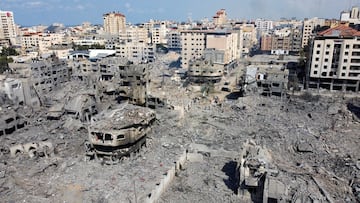WORLD
Where is Gaza and why is it a conflict zone between Israel and Palestine?
Located in Palestine between Israel and Egypt, this enclave has suffered continuous attack and destruction in the last 75 years.

Thousands are dead from the fallout from Hamas’ attack on Israel over the weekend, itself a response to the continuous Israeli occupation of Palestinian territory.
The Israeli response has been swift and brutal, sentencing the area from which Hamas militants operate, Gaza, to continuous bombardment. The Israeli government has restricted water, electricity, and food to the withered enclave in an apparent act of collective punishment.
Article 33 of the Fourth Geneva Convention
"No protected person may be punished for an offense he or she has not personally committed. Collective penalties and likewise all measures of intimidation or of terrorism are prohibited."
It is estimated 2 million people live in the area, 25 miles long by 6 miles wide, with around 50% of the population being children.
The Gaza Strip is one of the two territories controlled by the Government of the Palestinian National Authority, along with the West Bank, according to the 1993 Oslo agreements. However, the area remains since 2007 under the de facto control of Hamas, the group responsible for the atrocities.
The history of Gaza
Gaza has been the territory of several historical empires such as the Egyptian, Roman, and Ottoman Empires, before passing into British hands in the 20th century. During the first half of the 20th century, the British Mandate of Palestine governed the enclave, at which time there was an arrival of Jewish immigration from Europe to the region, which caused tensions between the Arab community already living there and the new Jewish community.
At the end of the Second World War, the decision on what to do with Palestine fell to the United Nations, which approved, Resolution 181 in 1947: “The Assembly divides Palestine into two States, one Arab and the other Jewish, with a special international regime for Jerusalem”.
In 1948, immediately after Israel’s creation, the Arab-Israeli war resulted in an Arab defeat, known in Arabic as the ‘Nakba’.
Israel took control of more of the territory, forcing Palestinian refugees to settle in Gaza. Another crucial moment was in 1967, when the Six-Day War began. Israel once again defeated the Arab coalition, formed by the United Arab Republic, a union of Egypt and Syria, Jordan and Iraq.
After this conflict, Israel occupied the Gaza Strip, the West Bank and Jerusalem, which led to the uprisings that continue. With no end in sight, the Government of Israel and the Palestine Liberation Organization (PLO) signed the 1993 Oslo Accords which aimed for a lasting peace.
With the signatures of Itzhak Rabin and Yasser Arafat, the creation of an interim Palestinian self-government under the Palestinian National Authority (PNA) was agreed. Israel withdrew from the Gaza Strip in 2005, dismantling its settlements and withdrawing its military presence. However, it maintained control over Gaza’s borders, airspace, and coastline, effectively imposing a blockade on the territory that continues to today.






